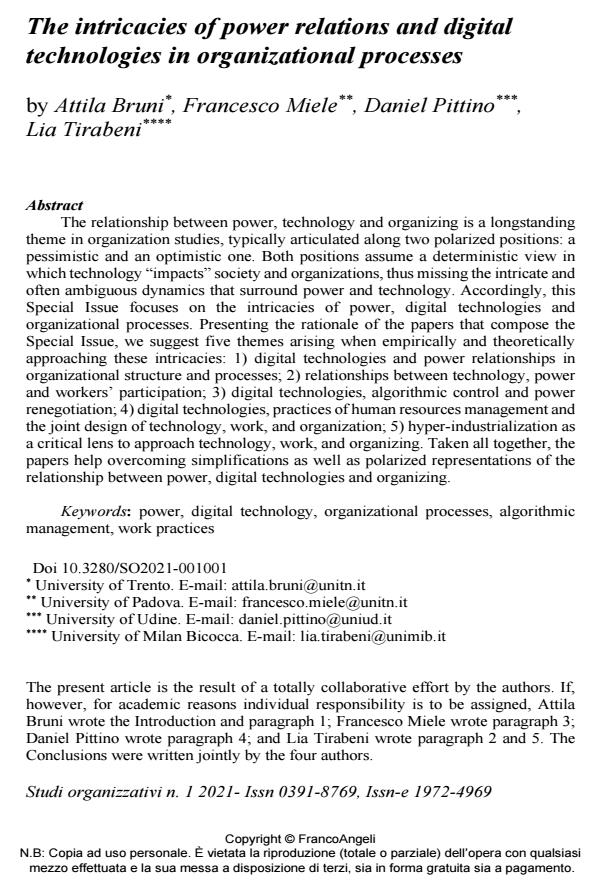The intricacies of power relations and digital technologies in organizational processes
Journal title STUDI ORGANIZZATIVI
Author/s Attila Bruni, Francesco Miele, Daniel Pittino, Lia Tirabeni
Publishing Year 2021 Issue 2021/1
Language English Pages 18 P. 7-24 File size 238 KB
DOI 10.3280/SO2021-001001
DOI is like a bar code for intellectual property: to have more infomation
click here
Below, you can see the article first page
If you want to buy this article in PDF format, you can do it, following the instructions to buy download credits

FrancoAngeli is member of Publishers International Linking Association, Inc (PILA), a not-for-profit association which run the CrossRef service enabling links to and from online scholarly content.
The relationship between power, technology and organizing is a longstanding theme in organization studies, typically articulated along two polarized positions: a pessimistic and an optimistic one. Both positions assume a deterministic view in which technology "impacts" society and organizations, thus missing the intricate and often ambiguous dynamics that surround power and technology. Accordingly, this Special Issue focuses on the intricacies of power, digital technologies and organizational processes. Presenting the rationale of the papers that compose the Special Issue, we suggest five themes arising when empirically and theoretically approaching these intricacies: 1) digital technologies and power relationships in organizational structure and processes; 2) relationships between technology, power and workers’ participation; 3) digital technologies, algorithmic control and power renegotiation; 4) digital technologies, practices of human resources management and the joint design of technology, work, and organization; 5) hyper-industrialization as a critical lens to approach technology, work, and organizing. Taken all together, the papers help overcoming simplifications as well as polarized representations of the relationship between power, digital technologies and organizing.
Keywords: power, digital technology, organizational processes, algorithmic management, work practices
- RETRACTED ARTICLE: Beyond the Swipe: Investigating the Interplay of Technology, Media, and Human Behavior in Digital Romance Ning Li, Bin Wang, Yanglin Li, Hao Pang, Xingzhi Han, in Journal of the Knowledge Economy /2024 pp.6124
DOI: 10.1007/s13132-024-01802-6 - Diversity and Inclusion in Italy Attila Bruni, pp.663 (ISBN:978-3-031-81937-7)
- Navigating Digital Transformation Lia Tirabeni, pp.113 (ISBN:978-3-031-76969-6)
- Engaging the body, appropriating a corporate wellness programme Enrico Attila Bruni, Filippo Andrei, Lia Tirabeni, in Qualitative Research in Organizations and Management: An International Journal /2022 pp.88
DOI: 10.1108/QROM-02-2022-2296 - Integration of parametric modeling tools in small architectural offices – between constraints and organizational strategies Adeline Stals, Catherine Elsen, Sylvie Jancart, in Architectural Engineering and Design Management /2022 pp.759
DOI: 10.1080/17452007.2022.2050347 - Reintroducing technology to the coworking debate: prospects and problematics Maddalena Sorrentino, Lia Tirabeni, Maria Laura Toraldo, in STUDI ORGANIZZATIVI 2/2023 pp.70
DOI: 10.3280/SO2022-002003
Attila Bruni, Francesco Miele, Daniel Pittino, Lia Tirabeni, The intricacies of power relations and digital technologies in organizational processes in "STUDI ORGANIZZATIVI " 1/2021, pp 7-24, DOI: 10.3280/SO2021-001001